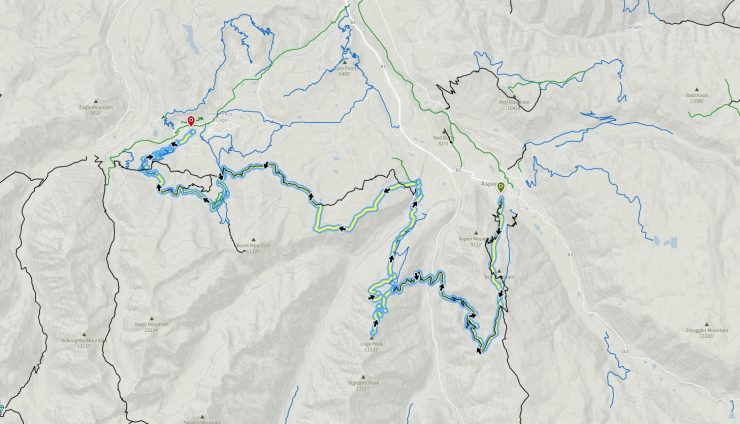 The Power of One during the Power of Four:
The Power of One during the Power of Four:
Here are some vital stats from trailrunproject.com as it relates to the Audi Power of Four 50k trail run in Aspen, Colorado: 32.6 miles, 9,873’ vertical climb, 9,407’ descent, 56 percent max grade, and 74 percent “runnable”.
This weekend, Simi Hamilton, U.S. Ski Team member and Aspen native was peerless in the men’s 50 k trail run. At 33 years old, Hamilton won the race in 5:18:37.1 hours. The second-place finisher, although nearing his fifth decade at 47-years-old, Troy Howard from Basalt, CO., was 56:42 minutes back.
“It’s really important for your psyche … you want to be able to revisit the racing mentality throughout the summer. Put a bib on and go through the same emotions, because that’s just as important as doing the intervals in the summer,” Hamilton told the Aspen Times after the race.


The 50 k grind tops out on Aspen’s four iconic ski areas which include Aspen Mountain, Aspen Highlands, Buttermilk, and Snowmass.
U.S. Ski Team teammate, and Hamilton’s wife, Sophie Caldwell Hamilton, made a last-minute decision to race Sunday’s 25 k Power of Two. Caldwell placed second in 2:17:50.4. Jessie Young of Aspen won the women’s 25 k in 2:17:50.4.
FIS Congress Postponed until Spring 2021: On July 31, the International Ski Federation (FIS) announced it would be postponing it’s upcoming FIS Congress originally scheduled for early October. The new date for the 52nd Congress is June 5, 2021 in Portoroz, Slovenia.
“The Council decision to postpone the FIS Congress 2020 is based on the FIS policy of respecting that the health and safety of all participants at all of its events as the highest priority,” FIS stated in a press release. “On the advice of the FIS Medical Committee Expert Group, organising the FIS Congress in October would not meet these standards of safety. Additionally, the current travel restrictions subject participants from many of the FIS member National Ski Associations’ countries to quarantine and other restrictions.”
A good read from Track & Field News:
A sound mantra in these unsettled times goes something like this: Focus on what you can control. There remains social upheaval due to the pandemic and a groundswell of anti-racist sentiment many hope will manifest in real systemic change. What comes next is anybody’s guess.
Working with a bare-bones budget is nothing new to those in the cross-country ski racing world. Beyond a few well-endowed elite cross-country ski clubs and collegiate teams, the axe always seems about to fall. In recent years the University of New Mexico has seen its program eliminated. Cross-country ski teams at the University of Alaska Anchorage and the University of Alaska Fairbanks were saved from elimination a few years back.
So a rethink or realignment when considering the status and viability of collegiate cross-country ski programs is nothing new.
Without going any further, we should state we have no information regarding any NCAA programs that might be in jeopardy. That said, we came across an excellent piece in Track & Field Times exploring what the post-COVID track and field world might resemble.
“Most would say It all started with COVID-19,” writes Jeff Hollobaugh in his piece titled What Will College Track Look Like On The Other Side? “Yet what we’re hearing from college coaches is that existential struggle they face has been a long time coming because the financial foundation for collegiate athletics is not nearly solid enough to bear the weight of football.
“Picture it: Div. I sports as the Titanic trying to thread its way through icy waters in the night. Enter the C19 iceberg. The worldwide outbreak threatens to sink everything from finances to schedules, putting college sports underwater in an unparalleled crisis.”
Hollobaugh explores a world where the coffers of NCAA football, the richest in the land, become diminished due to a reduced or canceled competition schedule.
“It’s estimated that a year without football means an average loss of $62 million for each Power 5 school,” claims Hollobaugh. (The Power 5 includes the ACC, Big 10, Big 12, Pac-12, and SEC).
This may seem far away from cross-country skiing. And for all practical purposes, it is. But it simply means that during a season and perhaps a year with curtailed competition, many of the bottom feeders in the sports world will most likely be going with less, if not without.
This is all just the tip of the iceberg. Hollobaugh provides solid reporting and informed analysis as he attempts to determine if a path forward exists for collegiate track and field.



